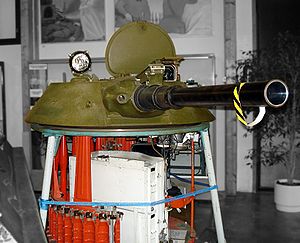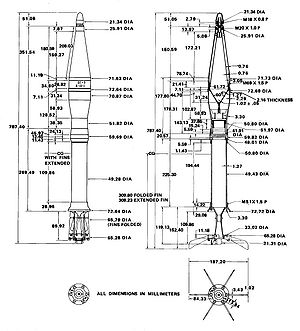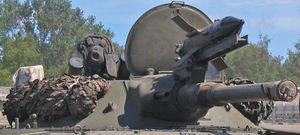2A28 Grom
The 2A28 Grom is the main armament of the BMP-1 Infantry fighting vehicle.
Description
The 2A28 is a 73 mm low pressure smoothbore semi-automatic gun with wedge breechblock. The gun is relatively compact and weighs 115 kilograms (254 lb). It is fed from a forty round mechanized conveyor double-row magazine located around the turret ring of the BMP.
In the BMP, the gun is brought to bear by electric motor, with a manual mechanical backup. The maximum horizontal and vertical traverse speed with the electrical system is 20 °/s and 6 °/s respectively. Minimum horizontal and vertical direction rate is correspondingly 0.1 °/s and 0.07 °/s. The gun can be depressed and elevated between –4° and +33°, with aimed fire possible up to an elevation of +15°. The turret can traverse 360°.[1] Cyclic rate of fire is between 8 and 10 rounds per minute, with the gun returning to an elevation of +3° 30' to reload after each shot if the autoloader is used.
The gun is reloaded by the M3 electromechanical autoloader with ammunition conveyor, but can be reloaded by hand if necessary. The autoloader is not reliable; it can break down from vibration when the vehicle is moving at high speed over rough ground, and its operation is a danger to the gunner's fingers. Using the autoloader, the gun has a rate of fire of 6–8 rounds per minute while a skilled gunner could easily achieve 10 rounds per minute. These drawbacks caused the autoloader to be removed in Ob'yekt 765Sp3 and Finnish BMP-1s. Some units removed the autoloader altogether when new vehicles were delivered, but the mechanized ammunition conveyor magazine was kept.
Ammunition
The 2A28 'Grom' smoothbore gun fires the same projectiles as the SPG-9 infantry light recoilless gun but with a smaller propellant charge. Before 1974 the ammunition consisted of high explosive anti-tank (HEAT) rounds only; the PG-15V HEAT fixed fin-stabilized rocket-assisted round. After 1974, OG-15V HE-Fragmentation projectiles were introduced. In the Ob'yekt 765Sp3, the standard ammunition load is 24 PG-15V HEAT rounds and 16 OG-15V HE-Frag rounds.
The PG-15V HEAT round weighs 3.47 kilograms (7 lb 10 oz) and uses a 2.6 kg (5 lb 12 oz) PG-9 shell with a 0.322 kg (11.4 oz) RDX explosive charge in the warhead.[1][2] A small PG-15P powder charge is used to boost the projectile from the gun barrel at 400 metres per second (1,300 ft/s). Once the projectile has travelled 10–20 m (33–66 ft), the rocket motor starts and accelerates it to 700 m/s (2,300 ft/s). If this low speed projectile's fins catch a crosswind it tends to "shuttlecock" with a consequent reduction in accuracy.
The OG-15V HE-Frag round weighs 4.57 kilograms (10 lb 1 oz), it uses a OG-9 shell with a 0.73 kg (1 lb 10 oz) TNT bursting charge.[3] The muzzle velocity of the OG-9 is 290 m/s (950 ft/s). The OG-15V is loaded by hand as it is too short to be handled by the autoloader.
Performance
The HEAT warhead can penetrate 280–350 millimetres (11–14 in) of steel armor – more than enough to penetrate the frontal armor of NATO main battle tanks (MBT)s of the 1970s, such as the US M60A1, the British Chieftain or the German Leopard 1.[4] The modernised PG-9 shell is able to penetrate up to 400 millimetres (16 in) of steel armor. The BMP-1's gun is unable to penetrate the front armor of modern NATO MBTs such as the US M1A1 Abrams, the British Challenger 2 or the German Leopard 2 but it has been claimed Template:By who that it can penetrate the side armor of these tanks in some areas.
On the ranges the PG-9 proved capable of hitting a 2-metre (6.6 ft) high target at a range of 765 metres (837 yd), while its maximum direct fire range is 1,300 metres (1,400 yd), reduced to 400 metres (440 yd) at night, due to the limitations of the night vision system. Under battlefield conditions it has a maximum effective range of 500 metres (550 yd)[5].
Maximum effective indirect range of the OG-15V HE-Frag round against formation targets is 4,400 metres (4,800 yd). Its effective direct fire range against small point targets is around 1,000 metres (1,100 yd).[1]
A coaxial 7.62 mm PKT machine gun is mounted to the right of the main armament for which the BMP-1 carries 2,000 rounds in belts of 250. They are stowed in two boxes under the main gun.[2] The machine gun has a rate of fire of around 200-250 rounds a minute.
The 2A28 'Grom' gun and PKT coaxial machine gun cannot be accurately fired while the vehicle moving over rough ground. This means that the BMP-1s main armament less capable than modern stabilised autocannons which can be fired accurately while moving. The BMP-1 is unable to engage tanks and APCs using the 2A28 'Grom' gun from hull-down positions due to its limited depression, making it vulnerable to enemy fire.[6] The limited elevation of the main gun, its lack of firepower and inaccuracy against point targets at 500–700 metres (550–770 yd) meant that it could not fight effectively in the mountains of Afghanistan.
The BMP-1 was a threat to NATO APCs, light AFVs and even MBTs, from the PG-15V shell at short range, and the 9M14M Malyutka-M anti-tank guided missile (ATGM) at longer ranges.
See also
Notes
Cite error: Invalid <references> tag;
parameter "group" is allowed only.
<references />, or <references group="..." />References
- Hull/Markov/Zaloga (1999). Soviet/Russian Armor and Artillery Design Practices: 1945 to Present. Darlington Productions. ISBN 1-892848-01-5.
- Zaloga, Steven (1995). BMP Infantry Fighting Vehicle 1967-94. Reading: Osprey Publishing. ISBN 9781855324336.


